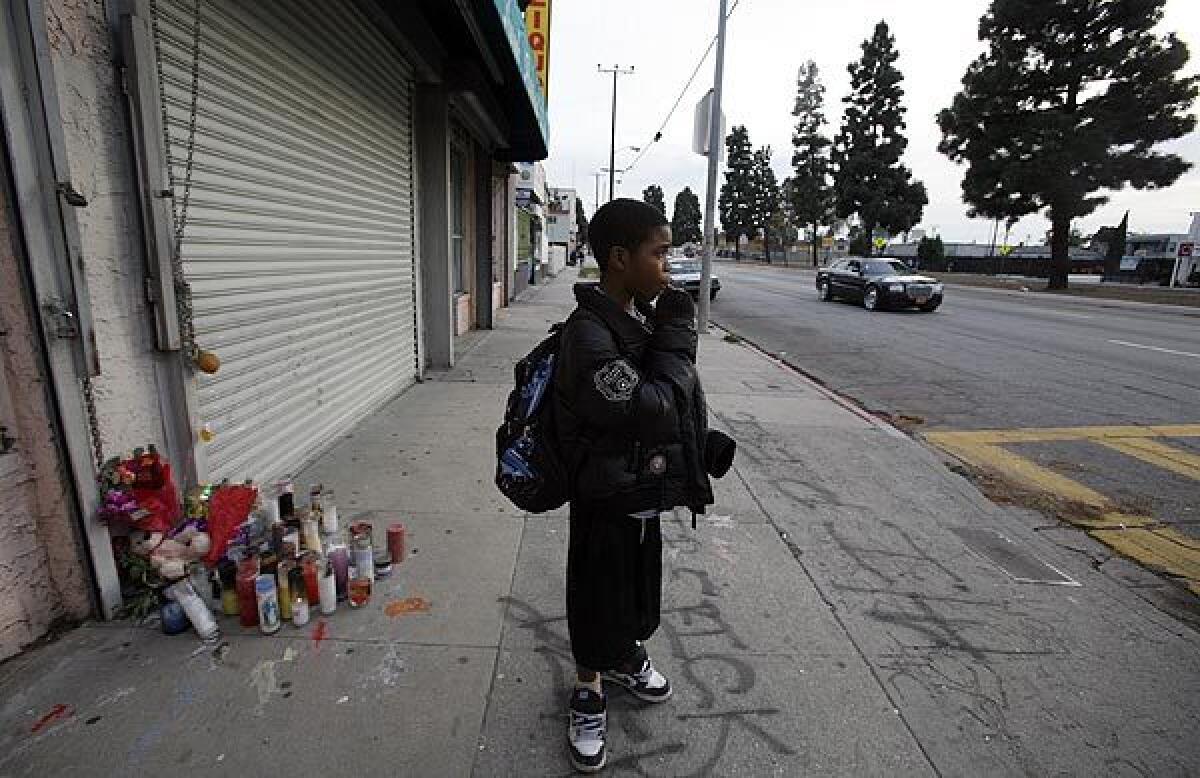Within South L.A.’s killing zone, a haven from violence

In the deadliest swath of Los Angeles County, where scores of people die at the hands of others each year, there is a haven that for years has known no murder.
For the last three years, no homicides have occurred in a remarkable patch of South Los Angeles. Measuring a mile wide from Hoover Street to Halldale Avenue and stretching from 73rd to 85th Street, it is an island encircled by the harsh realities of life in the urban core: One cannot walk a block outside its borders without coming across the site of a killing from the last three years.
The odd calm of the area is more striking when compared with a same-sized tract a mile directly to the south. There, on the grid of streets between 101st and 112th streets, 28 people were slain in the same time period. It is one of the deadliest neighborhoods in the county.
These two starkly disparate realities were detected as part of The Times’ ongoing effort to chronicle every homicide victim in Los Angeles County each year. On its website, the newspaper today launched a new version of the Homicide Report, which now allows readers to view the locations of homicides on maps, as well as analyze killings by various demographic factors. It is based on coroner’s data and Times reporting from the start of 2007 to the present.
The visual cues in the area that has been spared bloodshed, which is situated within the Vermont Knolls neighborhood, speak volumes. Most streets are lined with modest but appealing single-family houses. Frontyards often have no fences, the lawns are green and well-maintained. On recent days, a man meticulously swept the grass clippings off the sidewalk and young children rode scooters and bicycles without a parent to be seen.
There are some obvious reasons why this slice of Vermont Knolls is different. Over the last decade, an effort by the city and private investors has jump-started a rehabilitation of the commercial corridor along Vermont Avenue. Derelict buildings have slowly found tenants, pushing out people who once loitered and caused trouble, said Marqueece Harris-Dawson, president and chief executive of the Community Coalition, an influential advocacy group in the area.
Also, in the heart of the area is the Crenshaw Christian Center, a mega-church that occupies the old Pepperdine University campus stretching from Vermont to Normandie Avenue. The center dominates the landscape and serves as a hub for social activities and community outreach programs.
But other factors further separate the neighborhood from its more violent surroundings -- advantages that Harris-Dawson and others said cannot be easily repeated elsewhere.
The area is home, he said, to a generally older group of residents. The predominance of single-family homes instead of apartments means a less densely packed population and less turnover. And many in the neighborhood own their homes and have had roots in the area for generations.
The result is a place where people know each other, have an emotional and financial investment and don’t take kindly to anything that might disturb the peace.
“We gently urge people to get the outside of their homes together. And if they don’t keep them nice we’ll send them a little note,” said Lawrence Koonce Sr., who has lived on 81st Street for 43 years and is president of the local neighborhood watch group.
“People keep an eye out,” he added, saying that residents have built close ties to the Los Angeles Police Department officers who patrol the area. Koonce, 64, recalled a neighbor who watched a suspicious-looking stranger knocking on doors a few weeks ago and called police when the person tried to break into a house.
And, for years, police have targeted the Hoover gang, the predominant criminal group in the area. Most recently, in July 2007, a yearlong LAPD investigation resulted in the arrest of 18 Hoover members suspected in an array of violent crimes. The clique had been using as a base the home of one member’s grandmother in Vermont Knolls.
“Sometimes we fall asleep with the doors unlocked because it’s so comfortable,” said resident Marlene Turner.
A mile to the south, in the section of the Westmont neighborhood where 28 killings have occurred, residents live with no such sense of safety.
Densely packed, dreary apartment buildings catering to renters with Section 8 government subsidy vouchers are squeezed next to rundown houses that often have additional apartments added on. Real estate signs in front of boarded-up homes advertise foreclosure sales by banks. Street corners are dotted with liquor stores, coin-op laundries or small churches. The area, in many ways, is a cliche of urban blight.
On a recent day, two mothers sat perched on a cinder block wall keeping close watch over their children as they played on the sidewalk below. It was the same corner where Keith Orange, a 45-year-old black man, was shot to death a year ago, and a block away from seven other recent killings. Nearby, a group of several young black men sat on a stoop drinking from bottles of malt liquor. It is the type of place where a well-meaning resident greeted a reporter with the warning, “You shouldn’t be here.”
The level of violence is far less today than in the early 1990s, when the crack cocaine epidemic pushed homicide rates to more than double current numbers. The area, however, is still deadly.
“Walk outside at night? Oh, no, no, no,” said Evette Robinson, a waitress who has lived in the area with her two teenage daughters for nine years.
As many as 15 different gangs vie for control of the streets in the three-quarters of a square mile, and nearly all of the killings in the area are either known or suspected to be gang-related, said Chris Bergner, a sergeant in the Los Angeles County Sheriff’s anti-gang unit, which struggles to control the neighborhood’s streets. Gang territory can change from one block to the next and, unlike some neighborhoods where gangs fight to control drug sales on street corners, in this neighborhood there is relatively little drug dealing and blood is spilled over the smallest slights, whether real or perceived, Bergner and residents say.
“You’ve got these kids who just want to get a reputation, who kill just to be able to say they did it,” said former gang member Ken Cunningham, who now owns a small plumbing company and ministers at a local church. “There’s a mentality of ‘When in Rome, we do as the Romans do.’ ”
The victims in 21 of the 28 homicides were black men and women. Five were Latinos.
Too often, said Bergner and other law enforcement officials, witnesses to killings and other violent crimes refuse to cooperate with police out of fear of retaliation from gangs. “You can know exactly who committed a murder, and it doesn’t mean a thing because no one will say it aloud,” Bergner said.
In interviews, several residents were largely supportive of gang injunctions in the area and other efforts by the Sheriff’s Department, saying they wish for a greater police presence. But cops alone, many were quick to say, are not the solution. It is, they said, a neighborhood without any viable options to counter the pull of gangs. Unemployment is high and job training scarce. For youths, there is a dismal local high school, no parks, few after-school programs and little to do during the long summer months.
The killing of Joseph Watson stands as a sad reminder of such truths. The tall, quiet Washington Preparatory High School football player had tried to stay invisible to the gangs and follow the path of his stepfather, Jessie Adams, a retired cop. Whenever gang members shot at the boy or jumped him, Adams encouraged Watson to hang on. “I’d tell him, ‘Keep it up, just keep it up.’ ” Watson, 17, died on the sidewalk on Budlong Street from multiple gunshot wounds on a January night in 2007. Police suspect he was killed by a local gang member as punishment for his refusal to join.
Times staff writer Doug Smith contributed to this report.
More to Read
Start your day right
Sign up for Essential California for news, features and recommendations from the L.A. Times and beyond in your inbox six days a week.
You may occasionally receive promotional content from the Los Angeles Times.








